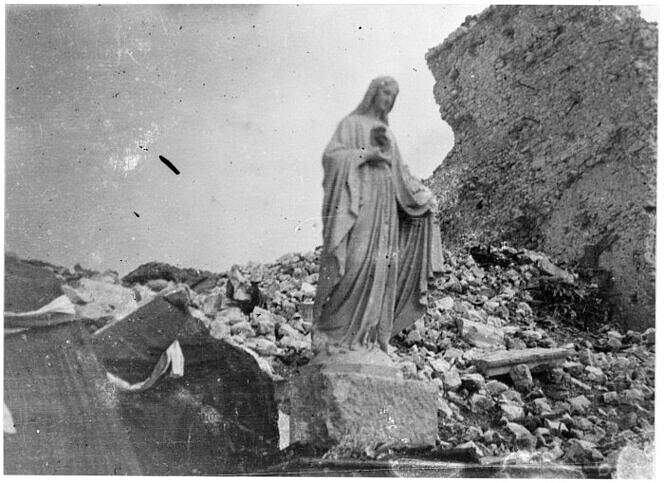
Statue of the Virgin Mary, Battle of Monte Cassino, Italy, 1944. Ross, L H. New Zealand. Department of Internal Affairs. War History Branch. Ref: DA-03750-E. Alexander Turnbull Library, Wellington, New Zealand /records/22726223 . Photo used with permission of the Library.
The 20th century has been a century of martyrs. Never before have as many people given their lives out of love for God than in those hundred years. It is too early to know what the 21st century will yield, but the martyrdom of the 21 men on the beach in Libya in 2015, of Father Hamel in France in 2016 and of many more show that martyrdom is not a thing of the past. According to a Pew Study from 2017, a report from Aid to the Church in Need from 2021 and a report commissioned by the British foreign secretary in 2019 – to mention just a few - , Christians are the most persecuted group in the world [1]. Though persecution in the West amounts, so far, to ridicule, some educational and professional disadvantages, and in a few rare cases lawsuits and prison, it mostly does not entail loss of life, as it regularly does in certain parts of South and East Asia, the Middle East and Africa.
But how is this tied to the blessed Mother? Not only did many martyrs like St. Maximilian Kolbe deeply love Mary (who offered him the graces of martyrdom and celibacy - he chose both), but she is also a model for all martyrs. Of course, Christ is the primary example, but Mary comes next and has been called “the Queen of Martyrs” through the ages. As St. Thomas Aquinas says, "to have the glory of Martyrdom, it is sufficient to exercise obedience in its highest degree, that is to say, to be obedient unto death." [2. 2, q. 124, a. 3].
Martyrdom is about being a witness, something all Christians are called to be, and this entails embracing the cross, accepting the void, the refusal of idolatrous pursuits, and living the virtues in a heroic manner. As Pope Benedict XVI clarified in his audience of August 11, 2010: “because martyrdom and the vocation to martyrdom are not the result of human effort but the response to a project and call of God, they are a gift of his grace that enables a person, out of love, to give his life for Christ and for the Church, hence for the world.” Mere willpower will not turn one into a martyr nor will the idolatrous and murderous fanaticism of a terrorist. Love is always at the core of martyrdom.
No mere human being has reached the perfection of the blessed Mother. Standing under the cross while seeing her Son in His agony being mocked and jeered at was no less difficult for her than had she been on it herself. Death would have been a liberation. The mater dolorosa is an image that has haunted the imagination of artists and others throughout the ages. “Whose pain is like mine?”, she cries to us. And when her Son ascended into Heaven, she had to remain on earth as presence and witness to the early Church. Despite Jesus’ presence in the Eucharist, the fact that He was absent to her senses must have been excruciatingly painful. Though Mary did not shed her blood literally, her heart broke during the Passion while uniting herself to Christ’s sacrifice, and it must have remained broken until the end of her life. She always knew through Scripture what bitter pains were awaiting her son, and this was confirmed by Simeon in the temple when he prophesied that a sword would pierce her heart, making her a martyr. "Mary was a Martyr," says St. Bernard, "not by the sword of the executioner, but by bitter sorrow of heart."
Hence the martyrs of the past hundred years are in a particular way Mary’s children, shedding their blood out of love for her Son and going through a complete kenosis just like she had to. They are therefore a witness not only to God’s goodness, but to her beauty and love as well. But whether they were martyrs by blood or not, they sang her praises during a time of great turmoil, a century of world wars, concentration camps, persecution and widespread death. Marcel Van, St. Kolbe, St Edith Stein, St. Padre Pio, Frank Duff, St. Teresa of Calcutta, and St. Pope John Paul II – to mention just a few – loved the blessed Mother tenderly and spread her devotion throughout the world.
Karl Rahner famously coined the phrase that the Christian of the future would be a mystic or would not exist at all. I’d like to change that into “the Christian of the future will have a Marian devotion or will not exist at all”. Mary is a shield and protects her children with her mantle against the attacks of the devil, giving them the grace to stand up for her Son whatever the consequences may be.
May the blessed Mother continue to watch over us during this 21st Century and help us bear witness to her Son.
https://www.churchinneed.org/christian-persecution/
This section looks at important figures and movements of the 20th and 21st century. These are assembled under different headings such as « mystics”, “orthodox figures”, “great witnesses and founders” as well as “authors”. Of course, some figures could be listed under various headings and will be cross-referenced.